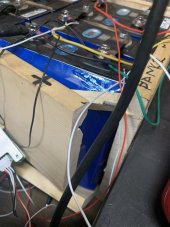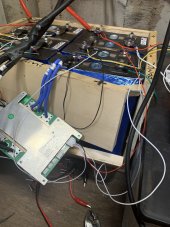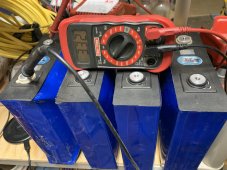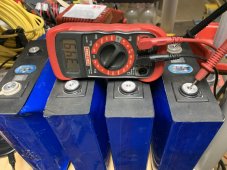Temp outside was 107*, inside the shed was less than 120*, so I can not see that being the problem.
I had two days prior added "Heltec Whole Group Balancer " to the mix, but can not imagine that overriding the BMS to allow runaway voltage.
The BMS, from aliexpress, was only one week new replacing a Daly which allowed up to 3.7v -Daly stated was OK but I could not get comfortable with.
Also, I am more comfortable topping out at 3.4V/13.6v to extend life of cells (I thought...)
Cell 1 expanded almost uncontrolled. Currently sits at 3.3v SOC after 4 days.
Cells 2,3,4 expanded but much less so. They currently sit at 3.50/51V.
So, a couple of questions:
-I assume the BMS is the cuplrit -any thoughts? I certainly do not want to attach it to my good bank to experiment.
-Is it possible that it was simply a faulty cell? I have had them for just over 1 month, but have certainly less than 10 full cycles of use.
-How could I test the remaining 3 to verify fitness for service, without pulling another cell from my good bank?
-Or is this simply an horrible idea, and just walk away from the $525 worth of cells?
I purchased cells from an amazon seller with no feedback, suspect, but do not want to pursue chargeback without a high degree of certainty.
Thank you in advance for any assistance

I had two days prior added "Heltec Whole Group Balancer " to the mix, but can not imagine that overriding the BMS to allow runaway voltage.
The BMS, from aliexpress, was only one week new replacing a Daly which allowed up to 3.7v -Daly stated was OK but I could not get comfortable with.
Also, I am more comfortable topping out at 3.4V/13.6v to extend life of cells (I thought...)
Cell 1 expanded almost uncontrolled. Currently sits at 3.3v SOC after 4 days.
Cells 2,3,4 expanded but much less so. They currently sit at 3.50/51V.
So, a couple of questions:
-I assume the BMS is the cuplrit -any thoughts? I certainly do not want to attach it to my good bank to experiment.
-Is it possible that it was simply a faulty cell? I have had them for just over 1 month, but have certainly less than 10 full cycles of use.
-How could I test the remaining 3 to verify fitness for service, without pulling another cell from my good bank?
-Or is this simply an horrible idea, and just walk away from the $525 worth of cells?
I purchased cells from an amazon seller with no feedback, suspect, but do not want to pursue chargeback without a high degree of certainty.
Thank you in advance for any assistance






